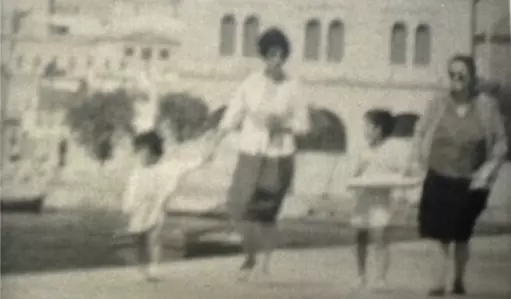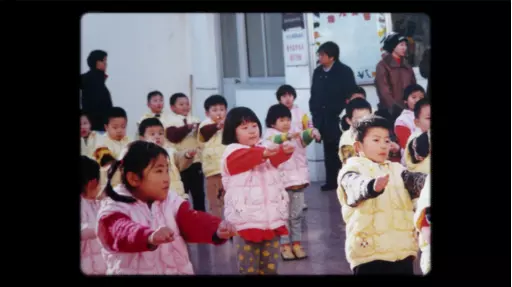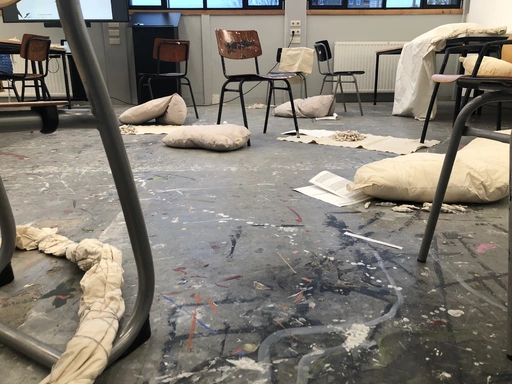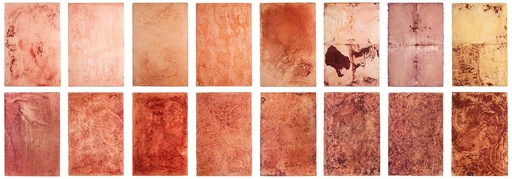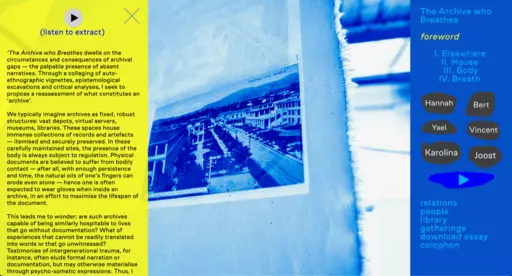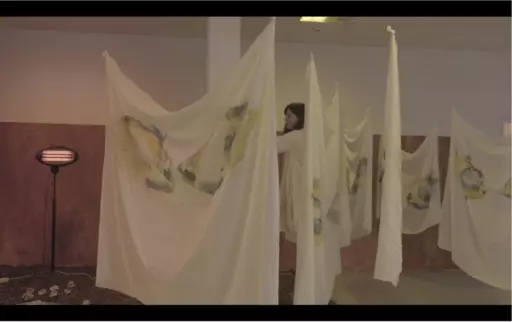
Bodies and Breath: Embodied Research & Writing
part of: Body and power(lessness)The series Bodies and Breath began with an inquiry into embodied research in practices of writing, art, craft, and performances: How do our experiences and (inherited) histories play a role in the way we envision research, the way we sense, imagine and make through writing, and the way we love what we do? What does research through writing make possible, and how does it rhyme and resonate with photographs, music, stories, memories, textures, and performances, and other materials and actions we make, transform, and inherit? Can we trace, release and translate (generational) knowledge, desires, trauma and silences that have been lodged in (our) bodies onto the page? What exists between remembering, forgetting and imagination?
As part of the research programme Body and Power(lessness), we invited artists, makers, filmmakers to host workshops on embodied research and writing and to contribute to this series with an essay. Please take time to also watch the video essay The Timeless Morphs: 3 Body Sessions that visual artist and designer Kexin Hao especially made for this series.
dis-membered / re-membered
contested pasts, archives, and counter-memories of diaspora
Sitting with family albums, pictures and memories that are not her own, and speaking along with the words of scholars in community—along with writers and artists who have contributed to the series Bodies and Breath—Asli Özgen focusses in her essay on audiovisual memories of contested pasts through a series of archival and activists practices. As a researcher, she follows the gaps and silences in archives, of the intergenerational memory of migrant, diasporic, exiled communities of women. As a film scholar, she studies the audiovisual heritage of ethnicised and radicalised diasporic communities - looking at the tension between how diasporic subjects are seen by the state versus how they see and narrate themselves. Asli Özgen is Assistant Professor Media and Culture at the University of Amsterdam.
Body Sessions
Video essay The Timeless Morphs by Kexin Hao
In this video essay The Timeless Morphs: 3 Body sessions, Kexin Hao takes us through her memories of growing up in Beijing, and her experience of alienation that resulted from the pressure to perform in dance and athletics. Folding the images and sounds of her memories into (collective) histories of the moving body, she asks: What is a disciplined and an undisciplined body? Weaving the personal family footage together with archival material, she looks into how the body is disciplined, and how it escapes disciplining measures through movement and memory. By recounting her memory of others and her own, this video essay speaks on how remembering creates a space for deviation, humor, entertainment, and power. This contribution includes an interview with the artist on her work and the uses of embodied research and writing methods. Kexin Hao is a visual artist and designer.
MY BODY IS A HOUSE
In My body is a house, Jeanine van Berkel’s prose moves us from inside her mouth to the core, along dust and bones. Listening to memories and ‘archival silences’ of (un)known histories of her motherlands, the gaps and silences she writes about slip between dreams, inherited histories, and imagination. Jeanine van Berkel is a graphic designer, visual researcher and writer.
Soft Histories
interview with Jeanine van Berkel
In this interview, we spoke with Jeanine van Berkel on how she engages embodied research and writing through the material she makes, the readings she holds, and the intimate spaces she invites us to. Jeanine van Berkel is a graphic designer, visual researcher and writer.
SOMEWHERE A BIT FURTHER AWAY
FOOTHILLS OF THE APPALACHIAS
NORTH CAROLINA, SOUTHEAST UNITED STATES
Color is not merely a pigment or a material property. Helena’s textual contribution Muddy Fields and writing workshop Muddy Fields and Pink Possums: field work and color work as an entry point for embodied writing begin with a simple question: What is color? Starting with her own body floating down the river, the question of ‘what’ is put aside, and color itself is encountered.
Slipping between the practical and the symbolic, economic and aesthetic, contemporary and historical, in her text color is a carrier that takes us through a vast array of relationships between the world and our selves. Made of desire as much as necessity, color takes us across lethal mining sites, global economies, and aesthetic hierarchies, prompting us to attune ourselves to the many registers and positions our bodies occupy at a given time.
Coming back to the question what is color, and resisting any single interpretation, can color, kaleidoscopically, prompt us to attune ourselves to our multifold experiences and registers of meaning—to the many worlds—we already inhabit? In the words of Helena: “…if one language or another limits us and censors how we are able to narrative our stories and history through inherent bias, then can color provide a tool through which we can sing ourselves back into the world?”
The Archive who Breathes
On the circumstances and consequences of archival gaps
The Archive who Breathes departs from a prose essay that addresses the tropes that have historically shaped the field of archive science, often resulting in gaps in institutionalised archives — and, by extension, sociological imagination. Hannah proposes a re-imagining of what may constitute an ‘archive’, addressing how testimonies of intergenerational traumas often elude formal documentation, and are otherwise materialised through psycho-somatic expression. Interweaving accounts from her own biography with theoretical and lyrical analyses, the essay asserts that the body can also be understood as an archival vessel – both hostage and host to aphasic legacies.
“This is the embodied archive — the archive ever circulating within you, for which you are both the abode and the custodian. It exists there, along the tide of your breath, cradled by your ribs, always present and animated — confirming that amongst the ghosts, there is surely life.” – Hannah Dawn Henderson
De schrijver als lichaam en het lichaam als schrijver
Hoe opnieuw te leren leven en schrijven met ziekte?
Ziekte is geen pose die je je kunt aanmeten, noch iets waar je afstand van kunt doen: dat is wat ziekte voor Moosje M Goosen definieert. Ziekte vraagt dan ook niet alleen om emancipatie in praktische opzicht maar ook om structurele veranderingen, zoals andere manieren van schrijven. Zo probeert Goosen schrijfvormen te introduceren die het gewicht van het lichaam mee laten wegen. Moosje M. Goosen is schrijver, onderzoeker en docent.
agenda
“Sometimes I’m Afraid of Ruining What I Have” lecture by Helena Sanders
Lecture by Helena Sanders
23 mrt. 2023AKI Auditorium Enschede 10:00 - 11:30
